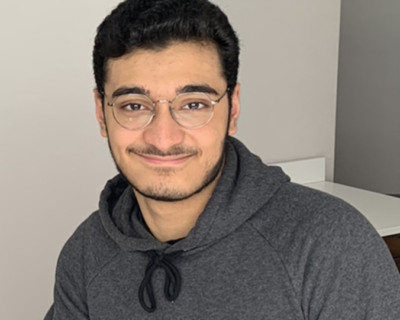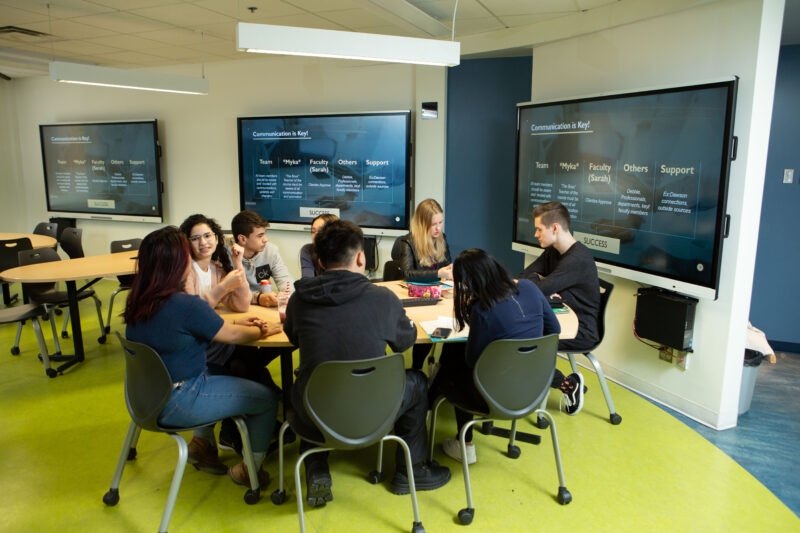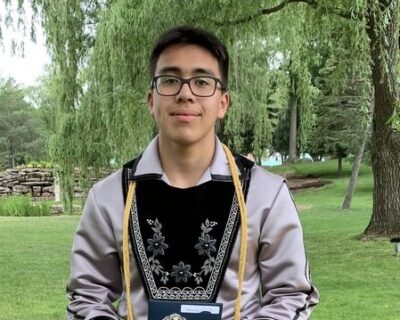Student perspectives on Dawson’s active learning pedagogy
The Dawson Active Learning Community (DALC) is celebrating 10 years of promoting active learning pedagogy at Dawson. More than 100 faculty members have been part of DALC. Active learning is established as a proven pedagogy that transforms students and teachers.
As the anniversary year nears its close, we asked some students to share their experiences with active learning classrooms. Here is what the students think in their own words.
Describe what happens in a typical class in an active learning classroom.
“Typically in these rooms, the teacher will begin by lecturing similar to a traditional classroom. However, the difference with the active learning rooms, is that the teacher creates the opportunity for interactive activities at different breaks in the “traditional lecture”. After working through problems and activities that consolidate the material being taught, the teacher then goes through the examples with the entire class and addresses common mistakes or misconceptions.”
- Rotshennón:ni Two-Axe, a second-year student in Enriched Health Science; volunteer with the First Aid Student Team; co-coordinator of the IndigeSTEM peer tutor project for Indigenous Science students; and member of Dawson’s lacrosse team.
What’s the best thing about working in Dawson’s active learning classrooms?
“Being in these classes creates a better sense of community. Whether it is a student explaining the more difficult material in a different way to another student or the friendly competition between tables, it creates a certain bond in the class.”

- Brenda Truong, a second-year student in Enriched Health Science; Vice-President of Coda, and SMSE student representative on the Dawson Student Union.
“The immediate and frequent feedback that we students receive from our teachers when doing in class activities. Given that the smart boards we work on are visible to everyone in the classroom, other people can easily give us feedback on our work and help us improve in areas where we may have gaps in our knowledge. Also, the fact that we get feedback on our work very close to when we are first exposed to the material helps us pinpoint areas of difficulty early on in the learning process, which enables us to have a more smooth and comprehensive learning experience when we later study on our own.”

- Qasim Mughal, a second-year student in Dawson’s Enriched Health Science Program; executive member of the Dawson Muslim Student Association, as well as the Dawson Debate Union.
“The connections formed between my classmates and me. In other courses, discussing the theory with our classmates is hard since everyone is paying attention to the lecture. Therefore, most of us are under the impression of being the only one that does not grasp the theory. Nonetheless, I realize I am not alone in this kind of classroom. After coming to this realization, I have found the confidence to ask questions and clarifications to my classmates… Not only have I gained friends, but I have also gained study companions.”
- Anca V. Geana, a first-year student in the Enriched Health Science Program; representative of her program; member of the Sparkmind Club, which is focused on sharing a love for the sciences with children in elementary school.
“I would say that my favourite part about these classrooms is the connections that they allow for, both between students and with the material. I have gotten to know a fair number of students quite well on account of learning with them and engaging in the group work that often accompanies active learning. What’s more is that by working with several others to accomplish a common goal, I have been able to develop the ideas taught in class by hearing from a diversity of perspectives.”

- Joshua Onichino, a second-year student in Enriched Health Science; member of Dawson’s High-Energy Particle Physics group; peer tutor at Dawson; and senior editor for the Dawson Research Journal of Experimental Science.
How are your classes in one of these rooms different than a traditional classroom?
“The active learning classrooms encourage students to ask questions without having the same pressure as a traditional classroom by having the students set up in small groups around the teacher. They also establish teacher-student relationships without the same feeling of absolute authority on the side of teachers by having the teacher in the centre of everyone (in a much more approachable way).”
- Patrick Shaw, a second-year student in Enriched Health Science; President of Coda Dawson, a student initiative that raises funds for the Canadian Cancer Society; member of High Energy Particle Physics Group and Model United Nations
“They are different because the teachers really utilize the interactive nature of the classroom. They seem a lot more willing to include students and want them to participate. It just feels a lot more personal, which is nice. They pay attention to the students a lot more, which allows for better pacing and teaching.”
- Isabella Ruvo, a second-year student in the Enriched Health Science Program; SMSE student representative on the Dawson Student Union and active in student life.
“The greatest difference is the interaction among the students. In these classrooms, it is not the technology that makes the biggest difference but it is instead the approach. The physical set-up is intended for students to interact, which make it feel that it is ok to talk to the teacher. In short, I honestly believe that in a classroom like this, students are more prone to develop their curiosity. I believe it is a consequence of the trust that is put in students when allowing them to interact with their peers.”

- Alvaro Torres, a second-year student in Health Science; member of the neuroscience club, Model UN, the student council and the Science Program Committee representing the student group.
“In a traditional classroom, time is usually spent with the teacher lecturing and the students taking notes for the duration of class time. In an active learning classroom, a lot of time is spent doing collaborative work and learning by doing. This hands-on approach has made it far easier when revising class work and makes class much more fun and engaging.”
“My class is different from a traditional classroom because the students interact more with each other and the professor. It is much more focused on understanding the material and on the love of learning than on retaining the information for the final. We also spend much less time in class learning the theory (learned at home with the reflective writings) and more time on solving problems. Since it is the problems that are often challenging, this is a brilliant idea.”
- Anca V. Geana
“Compared to more traditional classrooms, the active learning classrooms provide students with a much more engaging and fulfilling learning experience. Sitting face to face with your peers and being able to see the other students in the class allows for a lot more interactions to occur between students when compared to traditional classrooms, where students are usually sitting in rows, all facing forward and rarely seeing the faces of their peers. This makes group work much more inclusive and enjoyable, and also fosters the development of closer relationships between students within a class and within a group. Also, the interactive learning that takes place in these classrooms, which is rarely possible in traditional classrooms, helps students better understand and apply concepts that they’ve learned in class, which leads to a better overall learning experience and environment.”
- Qasim Mughal
How do conversations with fellow students in active learning classrooms help you learn?
“It is amazing to see how much of what you don’t know can be explained to you by a classmate in simpler terms that by a teacher. As the people that surround you in the table are acquiring the knowledge at the same time, and come from a similar background, often my classmates present to me a particular way to understand a subject that tallows me to visualize in a more relatable way. I would say it happens daily, even if it is not something that I do not understand seeing others perspective deepens my understanding.”
- Alvaro Torres
“I found my conversations with my peers in these classrooms beneficial to my learning. Of course, whether it is by asking questions or by answering the interrogation of one of my classmates (active recall), it helps cement my knowledge and progress faster.”
- Anca V. Geana




